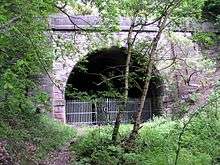Pudsey Loop
The Pudsey Loop was a railway line in West Yorkshire, England, which served the town of Pudsey and offered a second connection between Bramley and Stanningley in the east and Laisterdyke and Dudley Hill in the west, in addition to the existing line between Leeds and Bradford.
Route
The line branched off the Leeds–Bradford Exchange line west of Bramley. Shortly after, a track from Stanningley joined the line in a trailing junction, effectively forming a triangular junction. Just after passing under Lowtown street, the first intermediate station in Pudsey Lowtown was reached. Crossing under Robin Lane, Radcliffe Lane, South Parade, and New Street, the line reached second intermedate station and former terminus Pudsey Greenside. The two stations were located at either end of Pudsey town.
West of Pudsey Greenside station the line passed under Carlisle Road and through Greenside Tunnel, continued through a short cutting and on an almost straight embankment which was reported to be the largest of its kind in Europe,[1] passing under Smalewell Quarry track, over Tyersal Beck and Tyersal Lane, and under a farm track near Tyersal House. It joined the line from Ardswell and Gildersome to Laisterdyke at Cutlers Junction under the bridge of Arkwright Street, from where the tracks continued west to Laisterdyke on the Leeds–Bradford Exchange line and east to Shipley and Windhill on the Shipley and Windhill Line. Furthermore, a track connection existed south of Cutlers Junction between Tyersal Junction and Broad Lane Junction, forming another triangular junction.[2]
History
The line was built by the Great Northern Railway. A single-track branch line between Stanningley and Pudsey Greenside opened to passengers on 1 April 1878.[3] Freight traffic had already started in 1877.[4] The remainder of the line from Pudsey Greenside through the 618 yards (565 m) long Greenside Tunnel[4] to Cutlers Junction on the Ardsley to Laisterdyke line followed in 1893. At the same time an east-to-south curve near Bramley station was opened, thus completing the loop, which became a double-track through route. Upon the reorganisation of the British railways in 1921, it became part of the London and North Eastern Railway, and in 1949 part of the Eastern Region of British Railways.
Both intermediate stations and the line in its entirety closed on 15 June 1964. Bramley, Stanningley and Laisterdyke stations closed in 1967, although Bramley was reopened in 1983.[3]
Pudsey is now served by the station New Pudsey on the Calder Valley Line, opened on 6 March 1967 and located about 1 mile (1.6 km) from the town centre in Farsley.
Current situation
Any traces of the line between Bramley station and Mount Pleasant Road have been lost due to the construction of an industrial estate and of Stanningley Bypass. Sections of trackbed are preserved and can be walked between Mount Pleasant Road and Pudsey Lowtown and between the locations of the two Pudsey stations. The site of Pudsey Greenside station is occupied by warehouses.[3]
Planning permission had been granted to fill in Greenside Tunnel and the neighbouring cutting, however, work has not been started yet.[4] Tracks and ballast have been removed in the tunnel and along the whole line. Some bridges in the course of the embankment between Pudsey and Cutlers Junction have been removed, the cutting below Arkwright Lane has been filled in.[3]
Gallery
-

Bridge across the former line near Pudsey Lowtown
-

Cutting between Pudsey Lowtown and Pudsey Greenside
-

Western portal of Greenside tunnel
-

Bridge west of Greenside tunnel
References
- ↑ "7. The Greenside tunnel". West Leeds Country Park and green Gateways leaflet Phase 4. Woodhall Lake to Cockersdale. (PDF). 2008-01-15.
- ↑ Sheet 96 - Leeds & Bradford. One-inch England and Wales, New Popular Edition. Ordnance Survey. 1945–1947.
- 1 2 3 4 "Pudsey Loop. 1893 - 1964. Great Northern Railway". Lost Railways West Yorkshire. Retrieved 27 September 2016.
- 1 2 3 "Greenside Tunnel". Four by Three. 2016. Retrieved 28 September 2016.
External links
- Phill Davison. "Pudsey Greenside". Flickr.com. Retrieved 28 September 2016. - Photos of Greenside tunnel and its surroundings